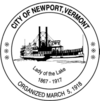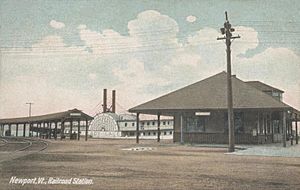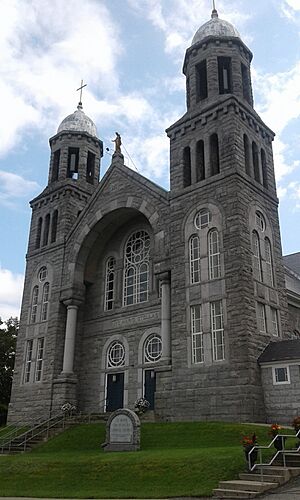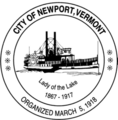Newport (city), Vermont facts for kids
Quick facts for kids
Newport, Vermont
|
||
|---|---|---|

Newport from Lake Memphremagog
|
||
|
||
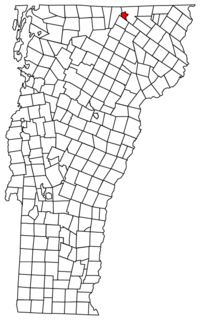
Location in Vermont
|
||
| Country | United States | |
| State | Vermont | |
| County | Orleans | |
| Organized | 1918 | |
| Area | ||
| • Total | 7.63 sq mi (19.76 km2) | |
| • Land | 5.83 sq mi (15.09 km2) | |
| • Water | 1.80 sq mi (4.67 km2) 20.87% | |
| Elevation | 722 ft (208 m) | |
| Population
(2020)
|
||
| • Total | 4,455 | |
| • Density | 583.9/sq mi (225.46/km2) | |
| Time zone | UTC−5 (Eastern (EST)) | |
| • Summer (DST) | UTC−4 (EDT) | |
| ZIP code |
05855
|
|
| Area code(s) | 802 | |
| FIPS code | 50-48850 | |
| GNIS feature ID | 1461773 | |
| Website | www.newportvermont.org | |
Newport is a city in Orleans County, Vermont, United States. It's the only city in the county and also its main town. In 2020, about 4,455 people lived here. Newport is the second-smallest city in Vermont by population. There's also a nearby town called Newport Town.
Newport was first settled by European Americans in 1793 and was called Pickerel Point. It was a place where Rogers' Rangers retreated in 1759 during the French and Indian War. The village grew a lot when the railroad arrived in 1863. Newport has two public schools, one private school, and a college branch.
Contents
History of Newport
Early Beginnings
In 1753, during the French and Indian War, a group of Abenaki people captured John Stark. They took him by canoe down Lake Memphremagog and landed where Newport is today. They held him until his family paid a ransom for his return.
Newport was founded in 1793, after the American Revolutionary War. It was first named Pickeral Point, then later called Lake Bridge because it was at the top of Lake Memphremagog. In 1816, part of the town of Salem joined Newport.
The railroad came to Newport in 1863. In 1868, the Lake Bridge settlement officially became the Village of Newport. It became a busy town for cutting and selling lumber. The company Prouty & Miller started its lumber business here in 1865.
Getting Around: Transportation
The Lady of the Lake steamboat began carrying people in 1867 and ran until 1917. This steamboat is now used as Newport's logo.
In 1868, a place to keep horses for travel, called a livery stable, opened near the railway station. At its busiest, it held 100 horses.
By the late 1800s, the Boston & Maine and Central Vermont railroads came through Lake Bridge. This made the village grow because it was easier to travel and trade goods. Passenger trains stopped running in 1965 as more people used cars.
In 1917, Main Street was paved. By 1930, about 4,000 cars drove on it every day. The city sold its airport to the state in the 1970s.
Military Events
Rogers' Rangers, a Vermont militia group, had to retreat through this area in 1759 after an attack in Quebec during the French and Indian War. They split up to confuse those chasing them.
During the American Civil War, Newport had a scare after the St. Albans Raid. People worried similar attacks might happen in Vermont. The local militia was called out, and armed Norwich University students arrived by train. Luckily, nothing happened, and everyone went home after a few days.
In 1891, the Reunion Society of Vermont Officers from the Civil War held their annual meeting in Newport.
Buildings and Architecture
In 1873, the Bellevue Hotel was built. It could hold 75 guests and later expanded to 100. It was called the Newport House by 1891 and was taken down in 1973.
The county courthouse we see today was built in 1886. The Field Opera House and Clock Tower was built in 1879 but burned down in 1896. The city's main building was later built on that spot. Lane's Opera House was built in 1892 and also burned down in 1923.
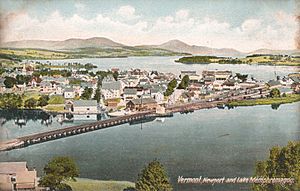
The Goodrich Memorial Library was built in 1899. Sacred Heart School opened in 1904 but closed in 2007 because fewer students were attending.
In 1917, the city of Newport was officially formed from parts of the towns of Newport and Derby. It started operating as a city on March 5, 1918. The city had four elementary schools and Newport High School. There were many businesses downtown and in other parts of the city.
The current federal courthouse was built in 1904. It used to include the United States post office, which has since moved.
Newport once had several neighborhoods with unique names like Chief-O and Skunk Hollow, but most of these names are not used much today.
Local Businesses
The Prouty & Miller lumbering company, which started in 1865, operated for over 100 years, closing in the 1980s. The Frost Veneer Mill was also a major employer.
Between 1936 and 1953, the International Club in Newport had the largest dance floor in New England. It was 220 by 60 feet (67 by 18 m) and could hold 2,000 dancers! Famous musicians like Louis Armstrong and Glenn Miller performed there.
Today, businesses like Poulin Grain, which ships farm feed, and a Columbia Forest Products plant employ many people. There's also a call center and a company that makes military combat helmets.
Geography and Climate
Newport is located on the southern shore of Lake Memphremagog. Three major rivers in the county – the Clyde, Barton, and Black – flow into the lake here.
The city covers about 7.6 square miles (20 square kilometres), with about 6.0 square miles (16 km2) of land and 1.6 square miles (4.1 km2) of water. Newport is next to the towns of Coventry to the south, Newport to the west, and Derby to the north and east.
Weather in Newport
| Climate data for Newport, Vermont (1991–2020 normals, extremes 1930–present) | |||||||||||||
|---|---|---|---|---|---|---|---|---|---|---|---|---|---|
| Month | Jan | Feb | Mar | Apr | May | Jun | Jul | Aug | Sep | Oct | Nov | Dec | Year |
| Record high °F (°C) | 64 (18) |
68 (20) |
83 (28) |
87 (31) |
94 (34) |
95 (35) |
98 (37) |
95 (35) |
96 (36) |
84 (29) |
75 (24) |
66 (19) |
98 (37) |
| Mean maximum °F (°C) | 46.8 (8.2) |
50.4 (10.2) |
59.2 (15.1) |
76.1 (24.5) |
84.7 (29.3) |
89.1 (31.7) |
89.5 (31.9) |
88.4 (31.3) |
84.9 (29.4) |
75.1 (23.9) |
63.7 (17.6) |
51.1 (10.6) |
90.0 (32.2) |
| Mean daily maximum °F (°C) | 23.4 (−4.8) |
27.1 (−2.7) |
36.6 (2.6) |
50.8 (10.4) |
64.8 (18.2) |
73.1 (22.8) |
77.7 (25.4) |
76.2 (24.6) |
68.9 (20.5) |
54.8 (12.7) |
41.1 (5.1) |
29.2 (−1.6) |
52.0 (11.1) |
| Daily mean °F (°C) | 13.7 (−10.2) |
16.0 (−8.9) |
25.8 (−3.4) |
40.0 (4.4) |
53.3 (11.8) |
62.3 (16.8) |
67.2 (19.6) |
65.3 (18.5) |
57.8 (14.3) |
45.2 (7.3) |
33.2 (0.7) |
21.3 (−5.9) |
41.8 (5.4) |
| Mean daily minimum °F (°C) | 3.9 (−15.6) |
5.0 (−15.0) |
14.9 (−9.5) |
29.2 (−1.6) |
41.9 (5.5) |
51.6 (10.9) |
56.6 (13.7) |
54.5 (12.5) |
46.8 (8.2) |
35.6 (2.0) |
25.3 (−3.7) |
13.5 (−10.3) |
31.6 (−0.2) |
| Mean minimum °F (°C) | −19.6 (−28.7) |
−15.1 (−26.2) |
−8.7 (−22.6) |
16.1 (−8.8) |
28.8 (−1.8) |
38.7 (3.7) |
46.2 (7.9) |
43.0 (6.1) |
32.3 (0.2) |
23.3 (−4.8) |
8.3 (−13.2) |
−9.0 (−22.8) |
−21.9 (−29.9) |
| Record low °F (°C) | −38 (−39) |
−38 (−39) |
−32 (−36) |
−2 (−19) |
20 (−7) |
28 (−2) |
36 (2) |
32 (0) |
23 (−5) |
11 (−12) |
−7 (−22) |
−40 (−40) |
−40 (−40) |
| Average precipitation inches (mm) | 2.83 (72) |
2.44 (62) |
2.83 (72) |
3.34 (85) |
3.94 (100) |
4.52 (115) |
4.54 (115) |
4.42 (112) |
3.93 (100) |
4.29 (109) |
3.35 (85) |
3.40 (86) |
43.83 (1,113) |
| Average snowfall inches (cm) | 21.5 (55) |
20.2 (51) |
18.4 (47) |
4.5 (11) |
0.0 (0.0) |
0.0 (0.0) |
0.0 (0.0) |
0.0 (0.0) |
0.0 (0.0) |
0.8 (2.0) |
7.0 (18) |
25.2 (64) |
98.6 (250) |
| Average extreme snow depth inches (cm) | 15.7 (40) |
20.7 (53) |
20.9 (53) |
9.0 (23) |
0.0 (0.0) |
0.0 (0.0) |
0.0 (0.0) |
0.0 (0.0) |
0.0 (0.0) |
0.6 (1.5) |
5.0 (13) |
11.4 (29) |
24.6 (62) |
| Average precipitation days (≥ 0.01 in) | 17.9 | 13.2 | 13.7 | 13.2 | 14.4 | 15.0 | 14.5 | 13.3 | 11.8 | 14.9 | 15.2 | 17.0 | 174.1 |
| Average snowy days (≥ 0.1 in) | 14.3 | 10.8 | 8.6 | 2.4 | 0.1 | 0.0 | 0.0 | 0.0 | 0.0 | 0.6 | 4.9 | 11.7 | 53.4 |
| Source: NOAA | |||||||||||||
People of Newport: Demographics
| Historical population | |||
|---|---|---|---|
| Census | Pop. | %± | |
| 1880 | 920 | — | |
| 1890 | 1,730 | 88.0% | |
| 1900 | 2,787 | 61.1% | |
| 1910 | 3,657 | 31.2% | |
| 1920 | 4,976 | 36.1% | |
| 1930 | 5,094 | 2.4% | |
| 1940 | 4,902 | −3.8% | |
| 1950 | 5,217 | 6.4% | |
| 1960 | 5,019 | −3.8% | |
| 1970 | 4,664 | −7.1% | |
| 1980 | 4,756 | 2.0% | |
| 1990 | 4,434 | −6.8% | |
| 2000 | 5,005 | 12.9% | |
| 2010 | 4,589 | −8.3% | |
| 2020 | 4,455 | −2.9% | |
| U.S. Decennial Census | |||
Newport's population stayed around 5,000 people until the 1950s, when it started to drop. By 2010, there were 4,589 people living in the city.
Most people in Newport are White. There are also smaller groups of African American, Native American, and Asian people. Some residents are of Hispanic or Latino background. Many people in Newport have French Canadian, English, or Irish family roots.
In 2010, there were 2,086 households. About 26.6% of these households had children under 18. The average household had 2.20 people. The median age in the city was 40 years old.
Newport's Economy
Money and Jobs
In 2017, the average household income in Newport was about $34,000. This was lower than the average for the whole state of Vermont. About 18.2% of the people in Newport lived below the poverty line.
Newport has the highest average income per person in Orleans County.
Local Industries
- Poulin Grain: This company sends farm feed products to customers in New England and New York. It employs about 50 people and makes feed all day, every day.
- Columbia Forest Products: This plant employs about 100 workers.
- A call center: This business employs 120 people.
- MSA: This company makes helmets for the military.
Fun for Visitors: Tourism
- A commercial ice fishing derby has been held every February since 2004. In 2010, 920 people participated.
- The only Soap Box Derby in Vermont happens in Newport every year. The winner gets to represent Vermont in the national competition.
- The local Rotary club has hosted an annual music festival for high schools in the county since 1947.
Education in Newport
Newport has two public schools: Newport City Elementary and North Country Union High School. There is also one private school, the United Christian Academy. United Christian Academy was formed in 1996 by Roman Catholic and Protestant churches to offer high school education. An elementary section was added later.
School Management
The city has a school board that manages Newport Elementary. This board includes Leo Willey (chair) and other members.
Newport also belongs to the North Country Supervisory Union with nearby towns. This union runs the North Country Union High School and the North Country Union Junior High School.
College Opportunities
Newport has a branch of the Community College of Vermont. Nearly 300 students attend here to earn an Associate's Degree.
City Infrastructure
Getting Around: Transportation
Main Roads
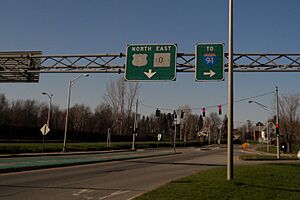
 U.S. Route 5: This road connects Newport with Coventry to the south and Derby to the north and east.
U.S. Route 5: This road connects Newport with Coventry to the south and Derby to the north and east. VT Route 105: This road connects Newport with Newport Town and Derby (it runs along with Route 5 in some parts).
VT Route 105: This road connects Newport with Newport Town and Derby (it runs along with Route 5 in some parts). VT Route 191: Also called the "Access Road," it connects Interstate 91, Exit 27, to the city of Newport.
VT Route 191: Also called the "Access Road," it connects Interstate 91, Exit 27, to the city of Newport.
U.S. Route 5 and VT Route 105 share much of their path through the city. Interstate 91 is the closest interstate highway, running through Derby. Two exits on I-91 lead to Newport.
Newport has six stoplights, which is most of the stoplights in the county. Five of them are on Route 5.
Important Bridges
There are three main bridges over the South Bay of Lake Memphremagog. Two of these connect different parts of the city: the bridge on Route 5 and the "Long Bridge" that connects Route 5 to Mt. Vernon Street. The Long Bridge is planned to be replaced soon. The third bridge is for the railway.
Local Buses and Trains
RCT (Rural Community Transportation) is a non-profit group that provides bus services in the area. There are buses running north and south from west Newport city to Derby during the week and on Saturdays. There is no bus fare.
Railroads
Newport was once a busy hub for trains like the Alouette and Red Wing. These trains connected Newport to cities like Montreal, New York City, and Boston. The last international passenger train stopped going across the border in the mid-1950s.
Today, the Washington County Railroad (WACR) operates the rail line for freight traffic. The Canadian Pacific Kansas City (CPKC) also operates a line that runs northwest towards Quebec and exchanges freight with the WACR in Newport.
The old Massawippi Valley Railway line, which used to go east of Lake Memphremagog, is now a path for bikes and walking.
Airport
The city is served by the Northeast Kingdom International Airport. It has two runways, each 4,000 feet (1,200 m) long.
Media in Newport
- The Newport Daily Express: This newspaper is published every day except Saturdays and Sundays in Newport.
- Newport Dispatch: This is an online-only news source that updates daily.
Notable People from Newport
- Charles Francis Adams: The first owner of the Boston Bruins hockey team.
- Harry A. Black: A former Secretary of State of Vermont.
- Reginald W. Buzzell: A U.S. Army brigadier general who lived in Newport.
- David M. Camp: A former Lieutenant Governor of Vermont.
- Walter H. Cleary: A Chief Justice of the Vermont Supreme Court.
- Rudolph J. Daley: An Associate Justice of the Vermont Supreme Court.
- Lane Dwinell: The 69th Governor of New Hampshire.
- John L. Edwards: A lawyer and politician.
- Duane Graveline: An astronaut.
- Aaron H. Grout: Son of Josiah Grout and a Vermont Secretary of State.
- Josiah Grout: The 46th Governor of Vermont.
- George H. Prouty: The 52nd Governor of Vermont.
- Winston L. Prouty: A United States Senator.
- William Weston: A politician who served in the Vermont Senate.
Images for kids
See also
 In Spanish: Newport (Vermont) para niños
In Spanish: Newport (Vermont) para niños


